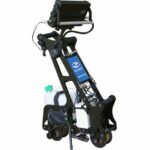






UDS2-73 raidetarkastuslaite ultraääni
- Kuvaus
- Pyydä tarjous
Kuvaus
The UDS2-73 flaw detector is intended for defect detection on the running surface of both rails and in the rail cross-section, excluding rail base blades.
It employs a flaw detection trolley for continuous testing and manual probes for confirmatory testing of individual rail cross-section segments and welded joints.
Flaw detector advantages
complete scanning of the rail (excluding rail base blades) due to the flaw detector multi-channeling;
built-in standard settings for channel operation;
determining the distance and speed during continuous testing;
real-time test result display in B-Scan mode (for 4 channels);
scanning and saving the information every other millimeter of traveled distance from all channels;
test results recorded at different sensitivity levels;
registration of all test results and advanced capabilities of data analysis;
the flaw detector with the standard scanning scheme applied enables detecting all types of fatal defects, appearing during the operation of a rail track.
Flaw detector distinctive features
large color high-contrast TFT display;
encoder synchronization;
information display forms: А-Scan, B-Scan;
number of channels for continuous testing: 26;
number of channels for manual testing: 2;
techniques and areas of rail head testing:
echo technique with an angle-beam probe for testing the field and gage side of the railhead in the direction of motion and against the direction of motion;
echo technique with an angle-beam probe for testing the central part of the railhead in the direction of motion and against the direction of motion;
echo-mirror technique with an angle-beam probe for testing the central part of the railhead in the direction of motion and against the direction of motion;
echo-mirror technique with an angle-beam probe for testing the field and gage side in the direction of motion and against the direction of motion;
Echo techniques for railhead testingEcho techniques for railhead testing
Fig. Echo techniques for railhead testing
echo-mirror techniques for railhead testingecho-mirror techniques for railhead testing
Fig. Echo-mirror techniques for railhead testing
Techniques and areas of testing the web and its projection in the base
echo and mirror-shadow techniques with a straight-beam single-crystal probe for detection of longitudinal horizontal cracks;
echo techniques with an angle-beam probe in the direction of motion and against the direction of motion for detection of transverse cracks and testing bolt holes;
Echo techniques for the web and base testingEcho techniques for the web and base testing
Fig. Echo techniques for testing the web and base
The flaw detector using the standard scanning schemes enables detecting all types of fatal defects with the following features:
Defects that can develop in railsTypes of sharp-defective rails
Fig. – Types of sharp-defective rails
transverse cracks in the 2nd-category railhead, including well-developed transverse cracks with reflecting surface, and also the ones developing under horizontal rolling surface separations which are not detected by the standard echo technique;
longitudinal horizontal cracks in the web, even if they do not reach the rail axis in their development, and also in the head, including the ones that do not go beyond the web projection;
longitudinal horizontal cracks located in the middle of the rail height;
cracks from bolt holes, including the ones at an early stage of their development when they do not go beyond the bolt hole projection onto the roll surface;
vertical cracks in the base and web located mainly along the rail axis;
transverse corrosion cracks in the base located in the web projection area.
Virhe: Yhteydenottolomaketta ei löytynyt.













